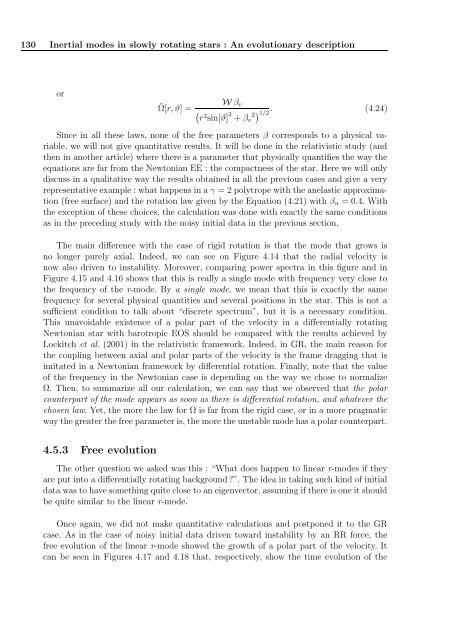Ecole doctorale de Physique de la région Parisienne (ED107)
Ecole doctorale de Physique de la région Parisienne (ED107)
Ecole doctorale de Physique de la région Parisienne (ED107)
Create successful ePaper yourself
Turn your PDF publications into a flip-book with our unique Google optimized e-Paper software.
130 Inertial mo<strong>de</strong>s in slowly rotating stars : An evolutionary <strong>de</strong>scription<br />
or<br />
˜Ω[r, ϑ] =<br />
W βv<br />
. (4.24)<br />
r2 2 21/2<br />
sin[ϑ] + βv<br />
Since in all these <strong>la</strong>ws, none of the free parameters β corresponds to a physical variable,<br />
we will not give quantitative results. It will be done in the re<strong>la</strong>tivistic study (and<br />
then in another article) where there is a parameter that physically quantifies the way the<br />
equations are far from the Newtonian EE : the compactness of the star. Here we will only<br />
discuss in a qualitative way the results obtained in all the previous cases and give a very<br />
representative example : what happens in a γ = 2 polytrope with the ane<strong>la</strong>stic approximation<br />
(free surface) and the rotation <strong>la</strong>w given by the Equation (4.21) with βn = 0.4. With<br />
the exception of these choices, the calcu<strong>la</strong>tion was done with exactly the same conditions<br />
as in the preceding study with the noisy initial data in the previous section.<br />
The main difference with the case of rigid rotation is that the mo<strong>de</strong> that grows is<br />
no longer purely axial. In<strong>de</strong>ed, we can see on Figure 4.14 that the radial velocity is<br />
now also driven to instability. Moreover, comparing power spectra in this figure and in<br />
Figure 4.15 and 4.16 shows that this is really a single mo<strong>de</strong> with frequency very close to<br />
the frequency of the r-mo<strong>de</strong>. By a single mo<strong>de</strong>, we mean that this is exactly the same<br />
frequency for several physical quantities and several positions in the star. This is not a<br />
sufficient condition to talk about “discrete spectrum”, but it is a necessary condition.<br />
This unavoidable existence of a po<strong>la</strong>r part of the velocity in a differentially rotating<br />
Newtonian star with barotropic EOS should be compared with the results achieved by<br />
Lockitch et al. (2001) in the re<strong>la</strong>tivistic framework. In<strong>de</strong>ed, in GR, the main reason for<br />
the coupling between axial and po<strong>la</strong>r parts of the velocity is the frame dragging that is<br />
imitated in a Newtonian framework by differential rotation. Finally, note that the value<br />
of the frequency in the Newtonian case is <strong>de</strong>pending on the way we chose to normalize<br />
Ω. Then, to summarize all our calcu<strong>la</strong>tion, we can say that we observed that the po<strong>la</strong>r<br />
counterpart of the mo<strong>de</strong> appears as soon as there is differential rotation, and whatever the<br />
chosen <strong>la</strong>w. Yet, the more the <strong>la</strong>w for Ω is far from the rigid case, or in a more pragmatic<br />
way the greater the free parameter is, the more the unstable mo<strong>de</strong> has a po<strong>la</strong>r counterpart.<br />
4.5.3 Free evolution<br />
The other question we asked was this : “What does happen to linear r-mo<strong>de</strong>s if they<br />
are put into a differentially rotating background ?”. The i<strong>de</strong>a in taking such kind of initial<br />
data was to have something quite close to an eigenvector, assuming if there is one it should<br />
be quite simi<strong>la</strong>r to the linear r-mo<strong>de</strong>.<br />
Once again, we did not make quantitative calcu<strong>la</strong>tions and postponed it to the GR<br />
case. As in the case of noisy initial data driven toward instability by an RR force, the<br />
free evolution of the linear r-mo<strong>de</strong> showed the growth of a po<strong>la</strong>r part of the velocity. It<br />
can be seen in Figures 4.17 and 4.18 that, respectively, show the time evolution of the
















